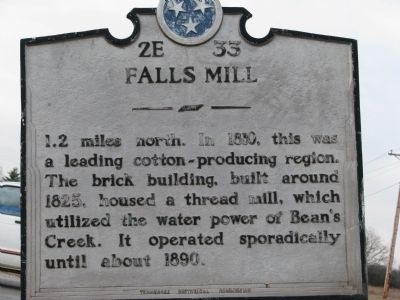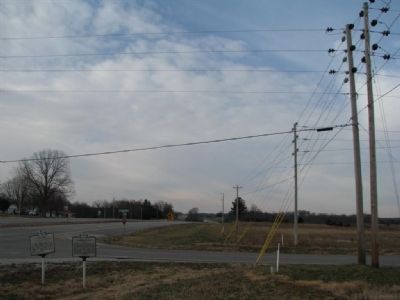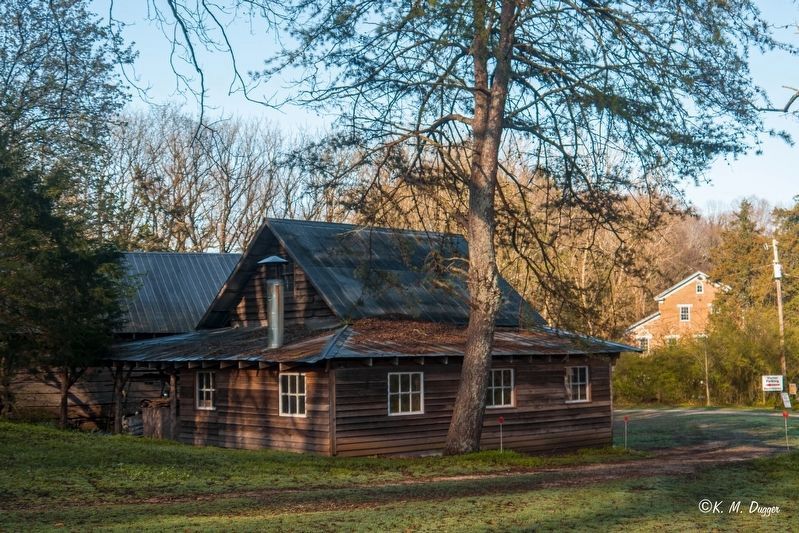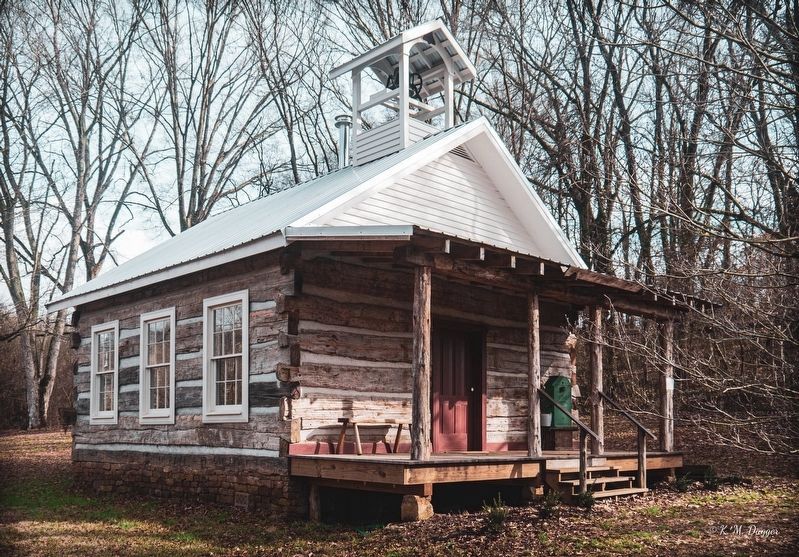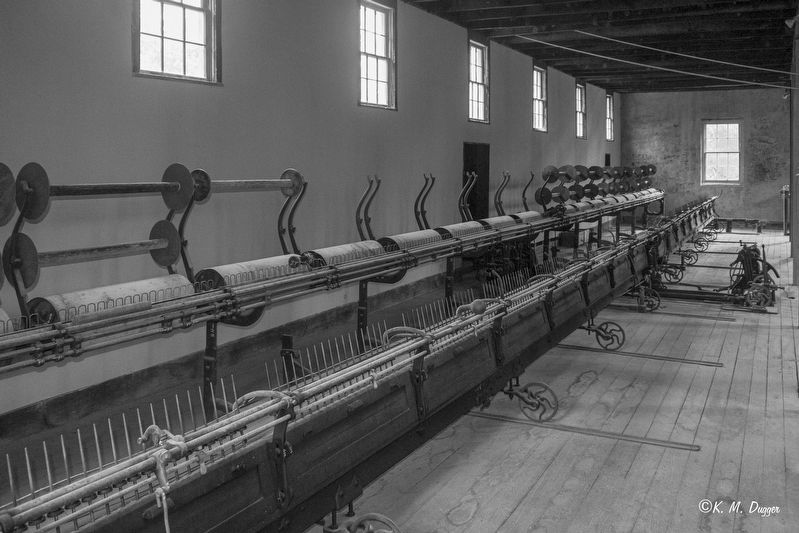Old Salem in Franklin County, Tennessee — The American South (East South Central)
Falls Mill
Erected by Tennessee Historical Commission. (Marker Number 2E 33.)
Topics and series. This historical marker is listed in these topic lists: Industry & Commerce • Notable Buildings. In addition, it is included in the Tennessee Historical Commission series list. A significant historical year for this entry is 1810.
Location. 35° 5.063′ N, 86° 15.04′ W. Marker is in Old Salem, Tennessee, in Franklin County. Marker is at the intersection of Route 64 and Old Salem Lexie Rd, on the right when traveling west on Route 64. Touch for map. Marker is in this post office area: Belvidere TN 37306, United States of America. Touch for directions.
Other nearby markers. At least 8 other markers are within 5 miles of this marker, measured as the crow flies. Jesse Bean (here, next to this marker); Polly Finlay Crockett (approx. 1.6 miles away); "Kentuck" (approx. 2 miles away); Huntland Veterans Memorial (approx. 2½ miles away); Hunter's Grocery (approx. 2½ miles away); John Ruch (approx. 3.6 miles away); Lincoln County / Franklin County (approx. 4 miles away); First United Church, U.C.C. (approx. 4.7 miles away).
Also see . . .
1. Falls Mill. (Submitted on January 3, 2010, by Tom Gillard of Tullahoma, Tennessee.)
2. Falls Mill Tennessee Facebook Page. (Submitted on January 3, 2020, by Kyle Dugger of Troy, Tennessee.)
Additional commentary.
1. Falls Mill, A Peacefull Escape
Everyone needs a place to escape to at some point in their life to find peace from the rushing around of daily life. With the seemingly non-stop lifestyles that most of us lead we sometimes forget, or feel guilty, about taking time off to slow down and break away from the normal day to day routine. Nestled down in a quiet and shady hollow in the hills of southern middle Tennessee you can find that perfect place to slow down and relax. Just outside of Belvidere Tennessee is Falls Mill, a water powered mill, museum, and Bed and Breakfast. For those who are interested in history or just want a relaxing getaway this is definitely the place for you. You can spend your days relaxing in the cabin, strolling along the bank of factory creek, wading in the cool clear water, or touring the mill and visiting with the owners, John and Janie Lovett.
Falls mill was built in 1873 as a cotton and woolen factory. Although Falls Mill started life as a woolen mill it has been other businesses through the years such as a cotton gin, wood working shop and grist mill. It is now the home of the Museum of Power and Industry, Inc. The mill is powered by a 32 foot diameter four foot wide Fitz waterwheel that was installed at Falls Mill in 1906. The steel Fitz wheel replaced an early wooden wheel that had broken its axle. The waterwheel powers machinery on multiple floors of the mill though a series a belts, pulleys, and line shafts. The water power is provided from a stone dam upstream of the mill that was built in 1871. Water is channeled from the dam, through the head-gate, to the top of the waterwheel. The mill began producing stone ground products in 1970 and continued until 2015 when food safety guidelines, which are designed for modern mills and not historic operations, forced the end of 45 years of commercial milling. I will have to admit that this left a sad place in my heart, but even though the mill is no longer commercially producing grits, meal, and flour the history is still very much alive. They do still sell their products, which are produced at a sister mill, complete with tasty recipes for grits, corn bread, and, my favorite, pancakes. There is just something about seeing and hearing the water wheel turn and feeling the rumbling through the building that makes it almost possible to see the people that walked the floors tending machinery years ago. The floor is worn, like
a well used path through the field, from the countless hours the works spent walking back and forth tending the carding machines. For me, Falls Mill is where my interest of water powere was first sparked. We took a family vacation here several years ago; the Bed and Breakfast had only been open for a couple of years. After our first day there I was so excited to get back inside that I was at mill before the miller. I was there watching as the mill race filled with water and as the gate at the top of the waterwheel was opened to begin the day’s work. I’m sure that I was a pest because I wanted to stay and watch all day.
Since the mill is no longer commercially grinding they have been able to move their focus to the original purpose of Falls Mill, a textile factory. There is an excellent collection of textile machinery on the three main floors of the mill. On the first floor are the mill stones, an 1866 wool carding machine, and a Chandler and Price letterpress along with several other pieces of equipment used in both grain milling and textile production. On the second floor you will find a country store, collection of 19th century power looms, hand looms, and spinning wheels. One very interesting piece of equipment on the second floor is an 1830’s era wool carding machine that has been restored to working order, after being idle for nearly ninety years. Equipment from
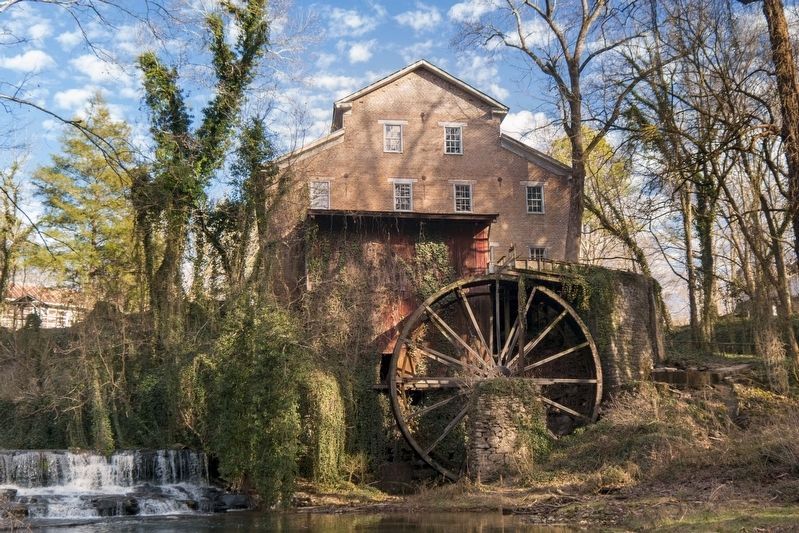
Photographed By Kyle Dugger, January 27, 2018
4. 32 Foot Fitz Water Wheel
This photo shows the 32' Fitz water that was installed at Falls Mill in 1906 which still powers machinery on all levels of the mill. It replaced an earlier wooden water. The mill race was moved from the North side of the building to the South side when this wheel was installed.
If spending the day watching flat belts tirelessly turn pulleys and shafts doesn’t sounds intriguing to you then the Bed and Breakfast might just hit the spot. It is an 1895 log cabin that has been transformed into the perfect retreat. Downstairs there is a small kitchen which is stocked with goodies from Janie’s kitchen, she is a fantastic cook. There is a wood burning fireplace that makes a great place to cuddle up and read a book during the chilly evenings of the winter months. Upstairs is the bedroom and bathroom, complete with a 1920s toilet. From the glider rocker on the front porch you can hear the sound of water rushing over the dam that provides water to power the mill. This is a great place to enjoy a cup of coffee in the morning with the delicious bread, muffins, or pastry that Janie has waiting in the kitchen for your breakfast. The cabin is a reminder of simpler times and that we don’t always have to be in such in a hurry. There is a journal in the cabin that has entries from previous guest and a place to write about your time spent there. While reading through it I found one entry that summed it up perfectly. She commented about the old fashioned wooden screen doors of the cabin that have a spring in the middle to hold them shut. When you let them close on their own they hit the door frame with an unmistakable “pop”. Hearing that sound brought back precious memories of her childhood and grandma telling her not to let the door slam; she even intentionally let the door close hard just to be able hear that sound again.
Whether you are looking for a place to explore history, get away and relax, relive long forgotten childhood memories,
or make new ones with your family; this could be just the place that you’ve been looking for. The Lovett’s are gracious host that have a passion for preserving history and teaching others about the past. The web site fallsmill.com has some of the history and contact information for the mill and the Bed and Breakfast. Who knows this place might just spark an interest in history for you or your family members, something that one can spend a lifetime exploring and never be at a loss for new and exciting places to visit and read about.
— Submitted January 3, 2020, by Kyle Dugger of Troy, Tennessee.
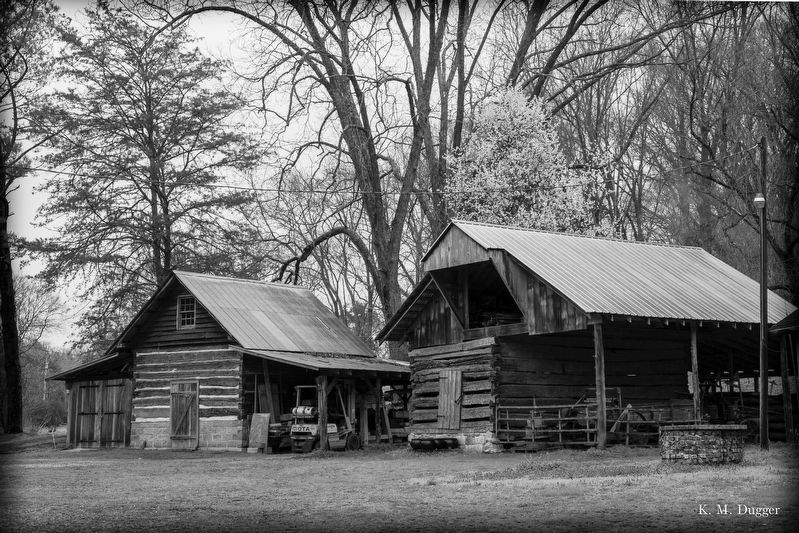
Photographed By Kyle Dugger, March 2, 2019
7. Falls Mill Shops
The building on the far left houses a blacksmith shop. This is a reproduction of the blacksmith shop that was once on the Falls Mill property. The original shop was located over the mill race and water for the forge could be accessed through a man hole cover.
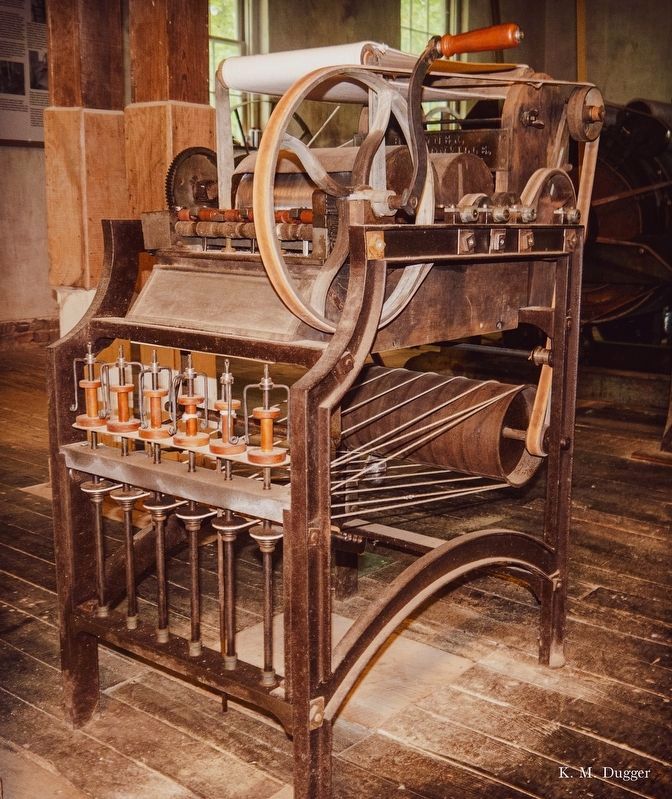
Photographed By Kyle Dugger, August 22, 2019
8. Falls Mill Plantation Spinner
This is a hand cranked machine that gins, cards, and spins cotton. The gins saws are arranged to create six streams of cotton. The raw cotton was placed on the feed apron on top of the machine and slowly feed to the saws. The seeds dropped down once the cotton was pulled off by the teeth of the saws and could be removed through a door under the feed bin. The spindles are powered by a single continuous band that is driven by the large drum at the rear of the machine.
Credits. This page was last revised on March 24, 2023. It was originally submitted on January 3, 2010, by Tom Gillard of Tullahoma, Tennessee. This page has been viewed 1,393 times since then and 47 times this year. Last updated on January 3, 2020, by Kyle Dugger of Troy, Tennessee. Photos: 1, 2. submitted on January 3, 2010, by Tom Gillard of Tullahoma, Tennessee. 3. submitted on March 23, 2023, by Kyle Dugger of Troy, Tennessee. 4. submitted on January 3, 2020, by Kyle Dugger of Troy, Tennessee. 5, 6. submitted on March 23, 2023, by Kyle Dugger of Troy, Tennessee. 7, 8. submitted on January 3, 2020, by Kyle Dugger of Troy, Tennessee. • Devry Becker Jones was the editor who published this page.
